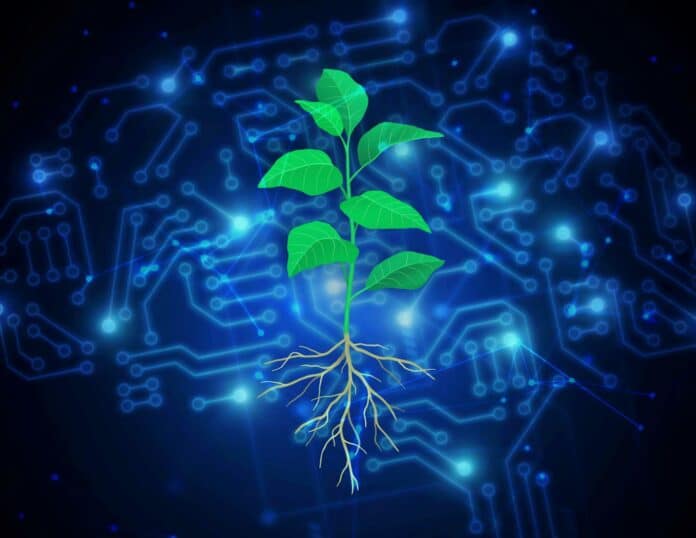Removing carbon from the atmosphere is now essential to tackling climate change and limiting the rising global temperature. To support these efforts, Salk scientists are designing climate-saving plants.
By enhancing the root systems of plants to store more carbon for a longer period of time, they are utilizing plants’ natural capacity to absorb carbon dioxide from the atmosphere.
Scientists working on Salk’s Harnessing Plants Initiative are employing a cutting-edge new research tool called SLEAP, an intuitive artificial intelligence (AI) program that monitors a variety of root growth characteristics, to design these climate-saving plants. SLEAP was initially developed by Salk Fellow Talmo Pereira to monitor animal movements in the laboratory. In order to adapt SLEAP to plants, Pereira has now teamed up with Professor Wolfgang Busch, a plant scientist and colleague at Salk.
In their study, scientists used SLEAP to examine plant root phenotypes, including how big and deep the roots get, how wide and deep they grow, and other physical characteristics that were difficult to detect before SLEAP. Scientists have already created the most extensive catalog of plant root system phenotypes to date, thanks to the use of SLEAP in plants.
Additionally, monitoring these physical traits of the root system aids in the identification of genes linked to these traits and the question of whether different characteristics of the root are influenced by the same genes or by other genes. Thanks to this, the Salk team can now ascertain which genes are most advantageous for their plant designs.
Salk Fellow Talmo Pereira said, “This collaboration is truly a testament to what makes Salk science so special and impactful. We’re not just ‘borrowing’ from different disciplines—we’re really putting them on equal footing to create something greater than the sum of its parts.”
SLEAP stands out because of its innovative application of deep learning—an artificial intelligence method for teaching a computer to learn and function like the human brain—and computer vision, which is the capacity for computers to comprehend images. With the help of this combination, scientists may process photos without going pixel-by-pixel, avoiding the labor-intensive intermediary phase and going right from the image input to the required plant attributes.
First author Elizabeth Berrigan, a bioinformatics analyst in Busch’s lab, said, “We created a robust protocol validated in multiple plant types that cuts down on analysis time and human error while emphasizing accessibility and ease-of-use—and it required no changes to the actual SLEAP software.”
The scientists have created a downloadable toolkit for SLEAP called sleap-roots (available as open-source software here) without changing its basic technology. Using sleep-roots, SLEAP can process biological characteristics of root systems, such as growth angle, mass, and depth.
The Salk team evaluated the sleep-roots package on a range of plants, including the model species Arabidopsis thaliana, a flowering weed in the mustard family, and agricultural plants such as canola, rice, and soybeans. They discovered that the innovative SLEAP-based approach beat previous methods for all tested plants. It was 1.5 times faster to annotate, 10 times faster to train the AI model, and 10 times faster to predict plant structure on fresh data, all with an accuracy that was either the same or higher than previously.
In conjunction with extensive genome sequencing endeavors to clarify genotype data across numerous crop varieties, phenotypic data—like a plant’s root system growing particularly intensely in the soil—may be extrapolated to decipher the genes accountable for developing that intense root system.
To build plants that store more carbon for longer periods of time, Salk’s aim of integrating genotype and phenotype is essential since those plants will require more profound, more robust root systems. By putting this precise and effective software into practice, the Harnessing Plants Initiative will be able to link desirable phenotypes to targetable genes with unprecedented speed and ease.
In conjunction with massive genome sequencing endeavors aimed at clarifying genotype data across numerous crop varieties, phenotypic data—like a plant’s root system growing particularly intensely in the soil—may be extrapolated to decipher the genes accountable for developing that intense root system.
To build plants that store more carbon for longer periods of time, Salk’s aim of integrating genotype and phenotype is essential since those plants will require more profound, more robust root systems. By putting this precise and effective software into practice, the Harnessing Plants Initiative can link desirable phenotypes to targetable genes with unprecedented speed and ease.
Salk colleague Professor Wolfgang Busch said, “We have already been able to create the most extensive catalog of plant root system phenotypes to date, which is really accelerating our research to create carbon-capturing plants that fight climate change. SLEAP has been so easy to apply and use, thanks to Talmo’s professional software design, and it will be an indispensable tool in my lab moving forward.”
When developing SLEAP and sleap-roots, Pereira prioritized reproducibility and accessibility. The researchers are eager to observe how sleap-roots is applied globally because the software and toolbox are freely available. They’ve already started talking to NASA scientists about using the instrument to study plants in orbit as well as to help direct carbon-sequestering plants on Earth.
Journal Reference:
- Elizabeth Berrigan, Lin Wang, Hannah Carrillo, Kimberly Echegoyen et al. Fast and efficient root phenotyping via pose estimation. Plant Phenomics. DOI: 10.34133/plantphenomics.0175
